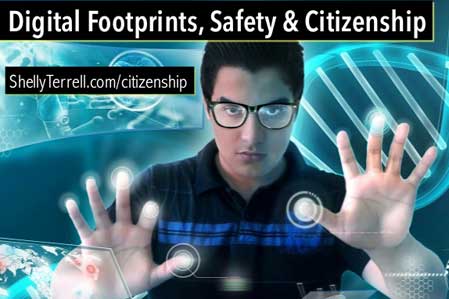Teach Digital Citizenship: 20+ Tips & Resources

“The most exciting breakthroughs of the 21st century will not occur because of technology but because of an expanding concept of what it means to be human.” – John Naisbitt
Our students’ digital behavior influences our learning, language, rituals, values, routines, customs, and communication. What we share, post, like, and comment on impacts us, our peers, and people around the world. Just think, a person took a picture and posted it online with the word, “Selfie!” Many took their own selfies and selfies with others, including the Pope. Selfie was the word of the year for 2013 (Brumfield, 2013). This example illustrates the power of our digital acts and choices. It is important we help our students create meaningful messages and learn to effectively collaborate and respect their peers. Below are slides, resources, and bookmarks to help you get your students to reflect on their digital acts and messages. This way you can facilitate and guide your students to make positive choices when they interact online.
Digital Footprints, Safety & Citizenship from Shelly Sanchez Terrell
- Create a community with digital icebreakers. Find a list of digital icebreakers I’ve created here!
- Get students to create avatars and introduce themselves. Younger kids will especially benefit from creating avatars. Find a list of avatar creation tools and ideas here!
- Teach citizenship with games! The following games are interactive and provide teachers and parents with resources for reinforcing the student learning- Quandarygame, Webonauts, and Cyber Pigs!
- Commonsensemedia.org has many resources for parents and teachers for all grade levels! Find app and site ratings, lesson ideas, and more!
- Find an awesome digital citizenship poster for young children at Thebookfairygoddess.blogspot.ca/2012/09/digital- citizenship.html
- Follow the #DigCit hashtag and website to find a community of educators who will support you in teaching your students citizenship
- Students can create eportfolios with social bookmarking tools and as a final project create eportfolio presentations in which they reflect on the learning for each module/unit. Check out my students’ reflective eportfolio presentations here!
- Pair or group students for projects so they learn the value of teamwork and collaboration. In Learning to Go find handouts for designating roles and permissions.
- You need to get parents on board with your technology integration. Get them to sign Responsible/Acceptable Use policies. Find example templates and other resources for engaging parents in my survival tips for engaging parents!
- Find interactive Youtube videos for teenagers at That’s Not Cool Two Sided Story Videos and the That’s Not Cool website.
Challenge:
Try one of these ideas to get students to reflect on their actions and choices.
Reference
Brumfield, B. (2013). Selfie named word of the year for 2013. Retrieved from http://www.cnn.com/2013/11/19/living/selfie-word-of-the-year/
Bookmarks
Tools and ideas to transform education. Sign up below.
cross posted at teacherrebootcamp.com
Shelly Terrell is an education consultant, technology trainer, and author. Read more at teacherrebootcamp.com.
Shelly Terrell is an education consultant, technology trainer, and author. Read more at teacherrebootcamp.com
